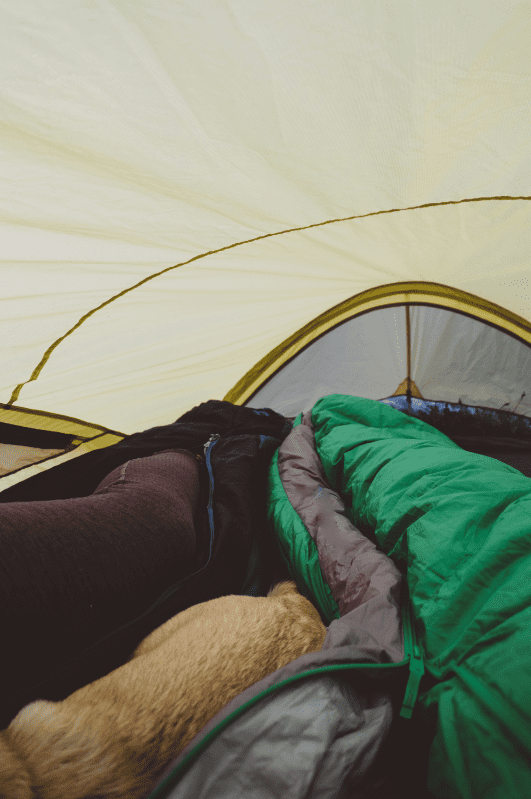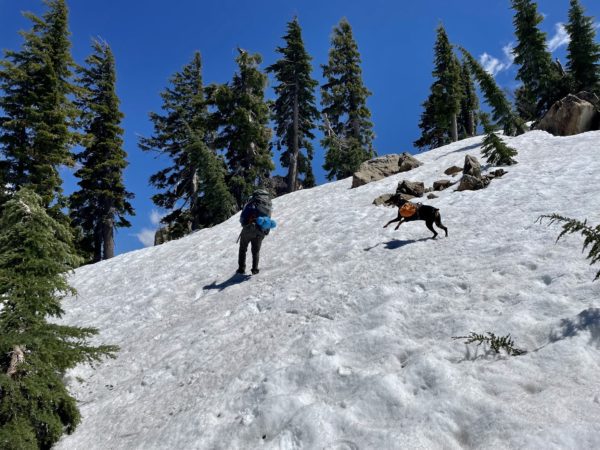 Getting good sleep in the backcountry can be a challenge, and a lousy night of rest does not make hiking enjoyable the next day. Here are a few tips to help you get better zzz’s.
Getting good sleep in the backcountry can be a challenge, and a lousy night of rest does not make hiking enjoyable the next day. Here are a few tips to help you get better zzz’s.
- Find a Comfortable Camp Site. Take your time scouting a flat, rock-free spot and clear away any sticks and pine cones before pitching your tent. If you are sensitive to light, try to avoid areas with a direct view of the night sky. The light from a gibbous or full moon can be bright enough to keep you awake. Open areas can be windy. Pitching your tent among trees will help block the moon and wind. If you must pitch your tent on an incline, sleep with your head on the slope. See more tips for finding a good campsite.
- Wear Earplugs. If noise at home easily awakens you, we suggest wearing earplugs on the trail. A night in the woods can be full of sounds you are not accustomed to hearing, such as coyotes howling and rodents wandering around searching for food. Many people get spooked by these sounds and have trouble falling back to sleep. Another option is to camp near moving water. The consistent sound of flowing water is soothing and will help mask strange sounds.
- Wear Comfortable Sleeping-only Clothes. Reserve your sleep clothes to ones you wear at night only. If you tend to have cold feet at night, wear socks! If you have cold hands, wear gloves. Studies show that covering your hands and feet makes it easier for the body to control core temperature, thus improving sleep. This works because heating the extremities causes vasodilation—widening the blood vessels—which facilitates heat redistribution to other body parts. Lowered body temperature signals to the brain that it is time to fall asleep.
- Sleep with a Pillow. Use your sleeping bag stuff sack as a pillow case and stuff it with clothing you plan to wear the next day. Plus, changing clothes will be accessible the next morning. If you don’t have a sleeping sack, use a small toddler pillowcase or purchase an inflating camp pillow. Supporting your neck will improve sleep quality and reduce neck pain.
- Drink Water and Take an Antihistamine. Most backpackers go to bed dehydrated, contributing to poor sleep quality and morning aches. Staying hydrated helps with blood circulation and reduces the likelihood of headaches at higher altitudes. Be sure to drink plenty of water after taking medication. You want to drink enough water before sleeping, but not so much that you will have to wake to pee in the middle of the night. It is also common to suffer from allergies when sleeping outside. If you wake up with a stuffy nose, take a drowsy antihistamine, such as Benadryl, within 1 hour of sleep. If aches and pains typically awaken you, take a dose of aspirin before bedtime.
- Generate Body Heat before Sleep. Do some light exercise before you get into your tent at night. Jumping jacks will warm you quickly. If you are already inside your tent and feeling cold, why not bust out a few push-ups or sit-ups to get your blood flowing? It is your body, not your sleeping bag, which generates the heat you need to get warm. Your sleeping bag merely traps your body heat to keep you warm.
- Eat a Hot Meal. Eat a hot meal 2 – 3 hours before sleep and a light snack right before bed. The digestion process generates body heat and will help warm you on cold nights. Eat foods that induce sleep, such as those containing the amino acid L-tryptophan, a substance that increases the levels of melatonin and serotonin, which are necessary for rest. Chia seed, pumpkin seed, and soy are all great plant sources of L-tryptophan. Avoid foods or drinks containing caffeine. A non-obvious source of caffeine is chocolate.
- Use Comfortable Sleeping Gear. Immobile soldier-like sleepers won’t have many problems using three-quarter-length pads and mummy bags. However, most humans tend to thrash around at night and like to curl up to fall asleep. If that is the case, you will need to choose your gear to match your ideal sleep position. If you like to sleep fetal-style with your legs curled up, you will find sleeping in a mummy bag restrictive. Get a quilt or a sleeping bag that fully unzips instead. Also, consider the width and length of your sleeping pad. Avoid sleeping on a thin, narrow sleeping pad if you sleep on your side or toss and turn a lot. Otherwise, your hips, elbows, and shoulders will frequent the hard, cold ground. Side sleepers will find foam pads painful on the hips. Air mattresses are best for side or stomach sleepers. If you are tall, consider the length of your pad. Most people don’t sleep well if their legs dangle off a three-quarter-length pad.
- Maintain your Sleep Schedule. After a long day of hiking, it is tempting to go to bed soon after it gets dark. Stay up close to your usual bedtime by stargazing or reading in your tent with your headlamp. Humans operate on daily wake and sleep patterns. No matter how tired you are, you should maintain your regular routine to feel your best.
- Practice Meditative Breathing to Fall Asleep. Alter your normal breathing by inhaling slowly through your nose and forcefully exhaling through your mouth. Continue to do this until your body is relaxed and your breathing becomes effortless.
If you are new to backpacking, keep in mind that getting good sleep in the wilderness takes practice and patience. Don’t be discouraged if you don’t sleep well the first few times you are in the great outdoors. With time and experience, you’ll learn what works best for you and develop strategies for getting a good night’s sleep.
Sleeping outside during the winter months can present greater challenges for staying warm. Here are a few tips for staying warm backpacking in cold weather.
